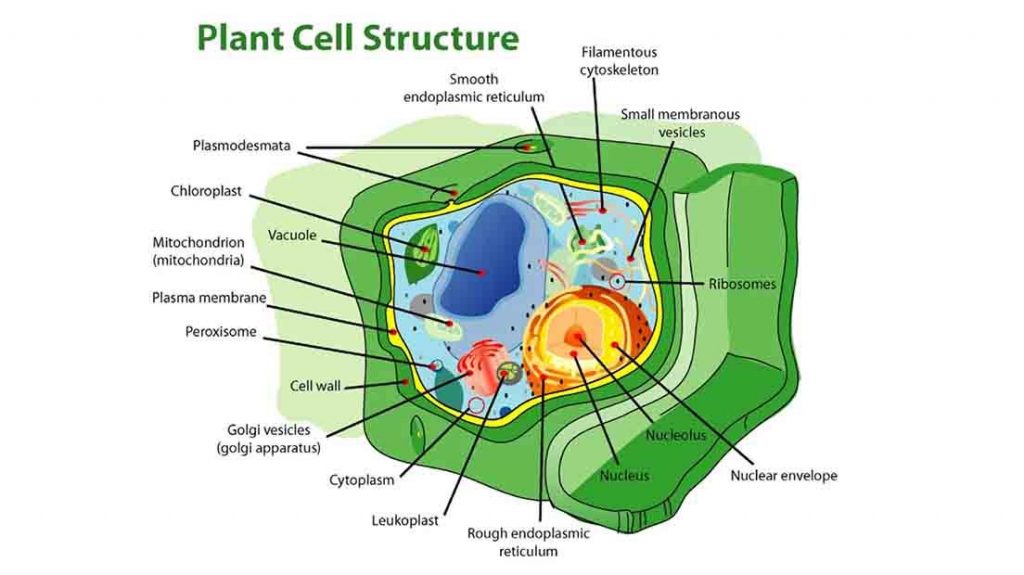Understanding Cannabis at the cellular level
Like every living thing, marijuana is made up of cells. The components of the cell form the structure and function of any living thing. Marijuana would cease to be marijuana if it had the cells of coffee. Understanding cannabis at the cellular level is essential in understanding how it works.
As we describe the functions of the different parts that make up the plant’s cells, you’ll notice that they function much like a factory. Also, every cell has a vital role to play and if one cog in the wheel fails, the chain is likely to break. Marijuana at the cellular level is made up of millions of different cells grouped into the following:
The Cell Walls
They act as the walls or the fortress of this gear. The cell walls are held together because they are composed mostly of cellulose. Although most animal cells are round, plant cells are square or rectangular. The walls of plant cells are composed of pectin, cellulose, and hemicellulose. Also, proteins and other compounds may be present.

The cell wall control what goes in and out of the cell. If the cell lacks water, the cell wall weakens, and would not be able to optimally keep pathogens out. When this happens, the plants become more vulnerable to fungal infections, bacteria, and other problems. Deficits in light and heat can cause cell walls to elongate, leading to poor leaf growth and low yields.
The Cell Membrane
Within the walls of the cell is a cell membrane composed of proteins and fats. Although it plays an important role in supporting and strengthening the cell, it is less rigid than the cell wall. The cell membrane plays a key role in determining which components can enter and leave cells.
In some cases, nutrients and particles pass through the marijuana cell wall but get rejected by the membrane. Other times, essential elements can slip out of the membrane, bounce off the cell wall and return to the interior of the cell. The two organelles are complementary.
The membrane not only functions as a kind of gatekeeper for nutrients that can access the Cannabis plant, but it also transmits and receives information from the cells around it. This allows the plant to react accordingly to changes in its environment.

When the environment gets too warm and the plant needs to cool down, the cell membrane sends a signal to the stomata, telling it to open its pores to allow the plant to increase its level of evaporation.
Sometimes when the cell gets too old or damaged, the membrane may start to leak unnecessary particles which may cause the cell to malfunction. This opens the membrane up to harmful substances, which in turn could kill the cell could die, which is detrimental to the well-being of the plant and the quality of Cannabis.
The Cytoplasm
The cytoplasm is another very important part of marijuana at the cellular level. It acts as which acts as a fluid where all the organelles of the cell are distributed. The cytoplasm is composed of water, nutrients, and other particles, such as proteins. The cytoplasm exists as a liquid and provides a means of transport between the organelles.
The Chloroplasts
Chloroplasts are disc-shaped organelles filled with dozens of tiny folds. They contain chlorophyll, the substance that gives marijuana plants their green colour. Chlorophyll is also responsible for photosynthesis, the process by which plants convert light in the presence of CO2, and H2O into glucose O2.
When light passes through cell walls and membranes, it reaches the chloroplasts where it is absorbed by chlorophyll. The chlorophyll in the chloroplast then seeks out lights of a specific wavelength. The light absorbed depends on the time of year and the plant’s stage in its life cycle.
Within the chloroplasts, absorbed light and carbon dioxide are converted into sugars for plants to use as needed. If there is not enough light and heat available to be absorbed, the chloroplasts will close, and photosynthesis cannot take place.
The Mitochondria
Using the analogy of marijuana as a factory the mitochondria would be the power plants of the system. When the chloroplasts absorb light, the mitochondria convert the light into energy to keep the cells alive and functioning.
The mitochondria give cannabis the power to grow and produce buds. At the cellular level, the mitochondria is one of the most important parts of the cannabis plant. They are also partially responsible for determining the potency of the buds.
Without adequate amounts of light and heat, the mitochondria have nothing to convert into energy, so plants wilt and die prematurely. When plants receive too much light and heat, the conversion process can go into overdrive, and that would be equally detrimental.
The Endoplasmic Reticulum
Returning to the analogy of a factory, the endoplasmic reticulum. The endoplasmic reticulum is a system of tunnels that connect the entire cell together. This endoplasmic reticulum is housed in the cytoplasm and connects to the cell nucleus.
In the cells of plants, the endoplasmic reticulum works closely with ribosomes and the Golgi apparatus to process, store or transfer proteins. This component also creates lipids or fats. When certain parts of the cell need proteins or lipids, the endoplasmic reticulum sends them to the appropriate destinations.
If a plant is exposed to unnecessary stress due to adverse growth conditions, the endoplasmic reticulum may rupture. As a result, proteins and lipids may not be stored or distributed properly. This could lead to a weakening of the cell wall and render the mitochondria unable to convert light into energy, as well as a host of other problems.
The Ribosomes and the Golgi Apparatus
The ribosomes are found in various parts of the plant cells. When nutrients are extracted from the air and soil, they are sent to the ribosomes. The ribosomes use these nutrients to create proteins and send them to the Golgi apparatus.
After receiving the proteins, the Golgi apparatus stores the proteins or modifies them according to the plant’s needs.
Many of the proteins are then transferred to the cell membrane because it constantly requires protein for its maintenance. Without proteins, the cell membrane cannot function well, which will affect the performance of the cell.
The Vacuole
In our analogy, the vacuole is the equivalent of a warehouse. The vacuole of the cell contains water that stores waste particles and nutrients. It increases the tension in the cell walls by pressing on them, thus making the plant rigid.
When the vacuoles lack enough tension, the cells will wither. As the vacuoles need water to create the tension, too little water will cause the plant to wilt. The vacuole also plays an important role in the plant’s rapid response to changes in water level.
As potassium moves from the vacuole into the cell fluid when the stomata close rapidly in response to a lack of water. The stomata can also have rapid responses to light, temperature, and carbon dioxide levels, which means that the plant can optimise photosynthesis and have a self-defense against external threats.
If you see some of the lower leaves of your cannabis plant start to turn yellow and die, don’t panic. This is a sign that an important process is taking place. When large amounts of waste need to be disposed of, they are deposited in the vacuoles of a leaf. This leaf is discarded when it falls off the plant.
The Nucleus
The nucleus (plural nuclei) acts as the nerve center of the marijuana plant’s cells. The nucleus is where most of the coordination of the cell takes place, hence fundamental to understanding marijuana at the cellular level.
The nucleus coordinates the organelles and other components of the cell. It also contains the cell’s DNA which determines virtually every imaginable trait from the specific strain of cannabis to the functioning of the cell. The DNA also decides whether the cell will be part of the root system, stems, leaves, buds, or anything else.
From the beginning, the nucleus contains the DNA of all cell types. This means that every cell has the potential to develop into any type. However, during development, the nutrients the cell receives, the hormones contained in the nucleus, and other factors influence the ultimate purpose of the cell in question.
Cooperation in Marijuana at the Cellular Level
The leaves, roots, and buds are formed from tissues, which in turn are made up of millions of cells. Since all cells need to cooperate to achieve this, communication between them is essential. Hormones act as information senders to coordinate the activities in the cell.
Occasionally, a cell needs to be reassigned to a new function. One such case is when a plant is cut down, as it requires new roots for the new plant to be able to absorb nutrients and water.
This means that shortly after parts of a plant is cut, it will develop new cells that have no speciality but will become root cells. In addition, the stomata on the leaves will close to prevent excess loss of water through evaporation.
The plant will use continue to energy from its reserves until the new roots have formed. This is an example of plants adapting to sudden or extreme changes in their environment through extreme organizational changes.
This has been all about marijuana at the cellular level. Why not continue reading with The Best cheap LED Lamps to grow Cannabis or The Best American Seed Banks.













